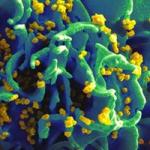
Heather Hickman, Ph.D.
Senior Investigator
Laboratory of Clinical Immunology and Microbiology
NIAID/DIR
Research Topics
Generating protective antiviral immunity is a complex process that begins at the infection or vaccination site, amplifies in the regional draining lymph node, and culminates in the prevention or resolution of tissue infection. Rationally designed vaccines are based on maximizing beneficial cellular and humoral responses while minimizing overly zealous reactions causing host pathology.
To fully harness the power of the immune response, it is critical to understand not only the effector functions of lymphocytes, but also the anatomy of immune responses leading to host protection. For instance, the precise location of leukocytes in the skin determines whether permissive cells are accessible to vector-borne viruses; likewise, intradermal vaccines can be transported to the draining lymph node by skin-resident cells. Inside the lymph node, T-cells are primed in distinct microenvironments in processes that are incompletely understood. In peripheral tissues, little is known concerning the precise location and movement of immune effectors, including those of virus-specific T-cells or B-cells. The goal of the Immunity and Pathogenesis Unit is to generate a detailed understanding of immunity to viral infection and vaccination in lymphoid and peripheral tissues, with an emphasis on the role of the anatomy on immunity.
Biography
Dr. Heather Hickman received her Ph.D. (Microbiology and Immunology) from the University of Oklahoma Health Sciences Center in 2003. While training in the lab of Dr. William Hildebrand, she investigated the presentation of viral ligands by major histocompatibility class I molecules. In 2004, she joined the Laboratory of Viral Diseases (LVD) (NIAID), first as a postdoctoral fellow with Dr. Jonathan Yewdell and later as a senior associate scientist. In the LVD, Dr. Hickman developed a research program aimed at better defining the mechanisms of adaptive immunity to viral infections using a number of different viruses as models (such as vaccinia, Zika, and influenza). Dr. Hickman became an Earl-Stadtman tenure-track investigator in the Viral Immunity and Pathogenesis Unit in 2017.
Selected Publications
- Aguilar CC, Kalia A, Brisse ME, Dowd KA, Wise-Dent O, Burgomaster KE, Droppo J, Pierson TC, Hickman HD. Subcapsular sinus macrophages maximize germinal center development in non-draining lymph nodes during blood-borne viral infection. Sci Immunol. 2024;9(93):eadi4926.
- Lujan RA, Pei L, Shannon JP, Dábilla N, Dolan PT, Hickman HD. Widespread and dynamic expression of granzyme C by skin-resident antiviral T cells. Front Immunol. 2023;14:1236595.
- Pei L, Overdahl KE, Shannon JP, Hornick KM, Jarmusch AK, Hickman HD. Profiling whole-tissue metabolic reprogramming during cutaneous poxvirus infection and clearance. J Virol. 2023;97(12):e0127223.
- Shannon JP, Vrba SM, Reynoso GV, Wynne-Jones E, Kamenyeva O, Malo CS, Cherry CR, McManus DT, Hickman HD. Group 1 innate lymphoid-cell-derived interferon-γ maintains anti-viral vigilance in the mucosal epithelium. Immunity. 2021;54(2):276-290.e5.
- Reynoso GV, Weisberg AS, Shannon JP, McManus DT, Shores L, Americo JL, Stan RV, Yewdell JW, Hickman HD. Lymph node conduits transport virions for rapid T cell activation. Nat Immunol. 2019;20(5):602-612.
Related Scientific Focus Areas


Microbiology and Infectious Diseases
View additional Principal Investigators in Microbiology and Infectious Diseases

This page was last updated on Friday, February 14, 2025